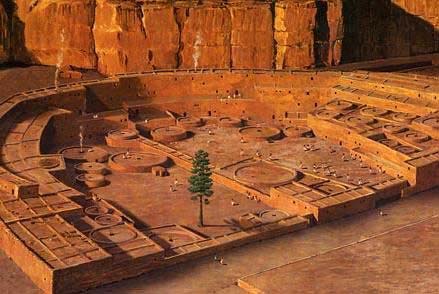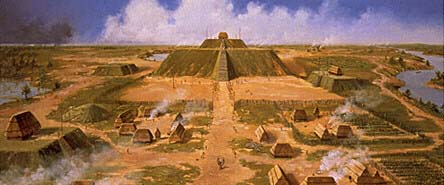When Columbus “discovered” the
New World, nearly 500 tribes with distinct cultural,
linguistic, and religious traditions were living
in North America. This course examines the development
of these diverse cultures from the earliest Ice
Age immigrants to the arrival of Europeans 500
years ago. We'll focus on selected prehistoric
groups in the Ohio-Mississippi River drainage,
Great Plains, Desert Southwest, and Great Lakes
Basin. Throughout the course, we will use
techniques employed by archaeologists to interpret,
explain, and describe the mosaic of prehistoric
cultures in North America.
The types of questions we'll investigate include:

13,000 Years Ago the
Clovis people hunted mammoth
|
1. Who were the first Americans? When
did they get here? Where did they come from?
What happened to them? Why did the Clovis
people and 80 species of plants and animals
disappear at the same time? |

Pueblo Bonito in
Chaco Canyon, New Mexico
|
2. How did farming develop in North America?
What lead to the development of villages
and towns in the Southwest |

A town in the Mississippi River Valley
|
3. How did the farming systems
of the central and eastern US differ from
the Southwest? Did cities develop in North
America?
|
This course has been developed for students
who have no prior experience in archaeology
or anthropology. There are no prerequisites,
and it fulfills the US Diversity requirement
for Liberal Studies. Education majors: this
class covers several components that must
be taught for the Arizona state standards
in history and geography.
Books:
We will be using articles that will be available
on-line. You can read the articles on-line
or you can download the articles and print
them. There is no textbook to purchase for
this course.
Course Format:
This course consists of twelve units. Each
unit has a series of virtual lectures, assigned
readings, and projects.
Grades will be based on exams, quizzes, and
essays. You can expect to spend two to three
hours per unit on the Internet. People with
a slow connection (less than 56k) might take
longer. Click
here for a sample course schedule.
F.A.Q. (Frequently
Asked Questions) about taking a web course
Click here for answers to frequently
asked questions.
Return to the main course selection page |
|


